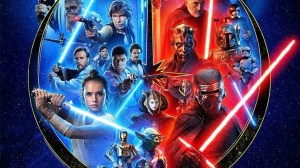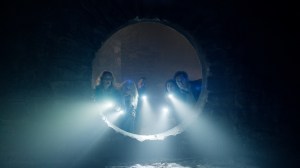The first season of The Lord of the Rings: The Rings of Power is almost wrapped up with just three episodes remaining. Considering the amount of directors that the average season of a TV series has, fans may be surprised to hear that only three directors carried the work load of its eight episodes. J. A. Bayona took the reign for the first two episodes with Charlotte Brändström directing episodes 6 and 7, leaving director Wayne Che Yip with the job of directing literally half of the show. Speaking with ComicBook.com in an exclusive interview, Yip, whose other credits include Doom Patrol, Doctor Who, and Preacher, opened up about carrying that much of the show and what it was like to bring elements of Tolkien’s mythology to life for the first time.
Videos by ComicBook.com
ComicBook.com: You get to direct the bulk of this first season of the TV show. How does it feel for you to be the person to make such a huge mark on the show by directing half of the season?
Wayne Che Yip: It was both obviously incredibly humbling and then exciting and then terrifying. Those three emotions are on repeat every single day for about a year and a half. At the end of the day, it was great. A story of this magnitude with this number of characters and this number of worlds, in many ways I think it was beneficial to have a smaller number of directors because we could, if anything, just help the actors and steward them through the story and just be a constant sort of reminder about where in the story their character is. Because a lot of times we need to shoot out of sequence, sets are ready at different times, locations are available at different times, weather.
Cont.’d
WY: So sometimes we will be shooting out of sequence and a big part of my job is just to remind everyone where they come from, what are we doing today, where are we going tomorrow? And especially with this genre where so much of it needs to be designed. In fact, everything needs to be designed. Everything needs to be designed, everything needs to be fabricated. We couldn’t go out to the store and buy any props. Maybe after the show there will be a whole line of Elven cutlery that you purchase, but at the time of shooting, if the script called for a dwarf to take a drink out of a mug, the mug needed to be designed. That was a series of meetings as to what that mug would look like. So for me as I said, a lot of my job was being there for these people to be almost like a consistent reminder of what we’re trying to achieve with the story, where we’re heading with it, making sure that what we were doing was true to what Patrick (McKay) and J.D. (Payne, showrunners) had written and what they wanted for the show.
CB: Now by that same extension, you get to be the director that brings things to life in live action from the Tolkien mythology that haven’t really been seen before. Specifically, Númenor is the biggest example. So what are the conversations like?
WY: They left me with immortal words of, “Don’t mess it up,” and so I took that to heart. Every single person that worked on the show was a fan in some way at some level. And so Ramsey Avery, production designer, Kate Hawley, our costume designer, and our amazing VFX team led by Ron Ames and Jason Smith. They had years and years already, before they’d even got this job, before they even knew there was going to be a Rings of Power TV show, they had had already in their minds as fans that the book, had already been designing Númenor. Already so much great work had already been done and it was more just sort of deciding what to use because a lot of times we just couldn’t use everything. And then the next step was to really approach it in the most sort of realistic way possible. What would it feel like to approach somewhere like Númenor for the first time? And we could imagine what it would be approaching other kind of famous harbor cities in the real world.
Cont.’d
And imagining, “Okay, if you arrived to New York on a ship, you wouldn’t suddenly just see everything all at once. You wouldn’t suddenly just be like, ‘Ah, Times Square and the Empire State and the Chrysler Building’ and everything.” You’d see the Statue of Liberty kind emerging from the mist first. And then you’d slowly start seeing life slowly, kind of sporadically, sort of being revealed to yourself. And so we wanted to at least try and start by grounding the experience of approaching Númenor, approaching the harbor in that sort of way that kind of slowly revealed the marvels and the wonder of this city piece by piece, one more amazing thing on top of another until we finally reached that harbor shot with Bear’s incredible music. And so it kind of felt like we were kind of unveiling it like a flower in a way, slowly sort of opening.
Cont.’d
So yeah, and everything else we just sort of thought, “Okay, well we wanted to design everything with this sort of veneer of realism.” We wanted to make sure that everything was there, everything there that you saw was for a reason. It didn’t have to be talked about. We didn’t have to understand, the viewer didn’t necessarily have to understand every aspect of it, but we wanted to make sure that we did and the Númenorian actors knew everything that was happening and why things were there. Nothing was there just because they looked good. We wanted everything to have a story and everything to be built from the ground upwards in terms of culture, in terms of design, art, what they believed in. And so yeah, it was really sort exciting and incredible experience, but we went deep with it.
CB: I always love to see the forced perspective shots that are key to making your smaller characters and your bigger characters look good in the frame together. How tricky are those to pull off but then also have you, what’s the secret to making them work
WY: Yeah, I mean, that is hands down, was the hardest thing. The most challenging thing in the whole show was making different actors different heights and just sort typically, or just Sod’s law, the actor that you needed to play the smallest character would actually be the tallest person in real life.There was a lot of planning. But one of our main goals was to try and make the experience as natural as possible for the actors. Because at the end of the day, if the performances weren’t there, it didn’t really necessarily matter whether we made someone look tall or look smaller. And so we worked very hard with the visual effects department to make sure that the actors could always, to some extent, act with each other.
Cont.’d
And then, on top of that, we had the latest technology, the latest camera, visual effects technology. And we also used the most sort of rudimentary, most old school techniques as well. Nothing was off the table as long as it looked right. If it looked right in the frame, then that was what we went with. Sometimes it was motion control, sometimes it was digging a hole in the ground or having someone be on their knees.
CB: There’s such a big balance between the practical and the visual effects in the show, but Is there maybe something in one of the episodes we’ve seen so far that you directed that people might be surprised to know was real and shot in camera?
WY: Yeah, actually the beginning of episode five where the stranger and Nori are talking to each other. That was classic forced perspective. Markella, who plays Nori, and Daniel plays The Stranger, they were just sitting on slightly different sized rocks. When we put the camera on it was something like, “Oh my god, she looks smaller than he does.” And they were just sort of sitting next to each other. And that for them, come episode five, that was the first time that those two actors actually got to share a scene together because all the other times they got to act with each other. But then, we’d only be using one side of the frame and then we’d be stitching that to a different side of the frame.
Cont.’d
And so all the other times when they shared a scene together, there’d be some sort of visual effects trickery that would make Nori feel smaller than the stranger. And then that scene, at the beginning of episode five when they talk to each other, is the one time that they actually managed to share the frame together. And that was all in-camera and didn’t actually involve any kind of postproduction. That was all in-camera forced perspective.








